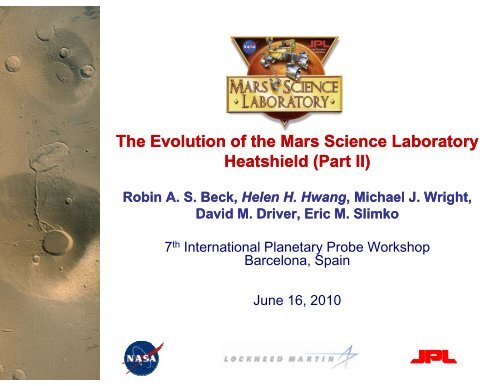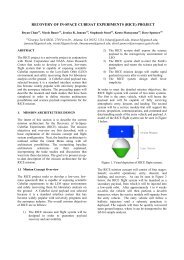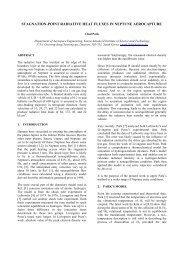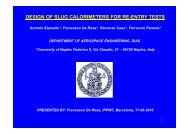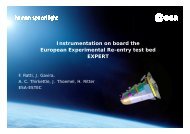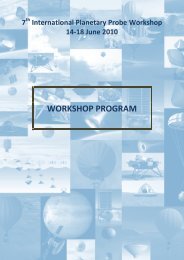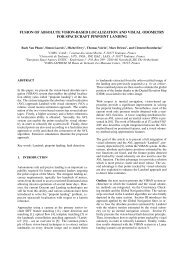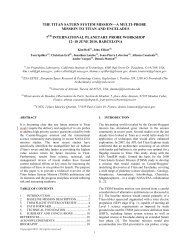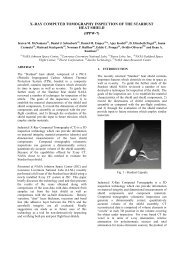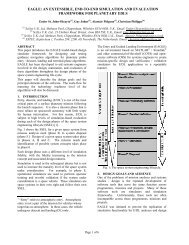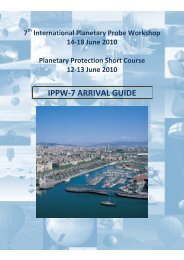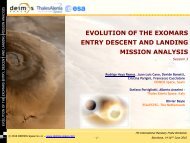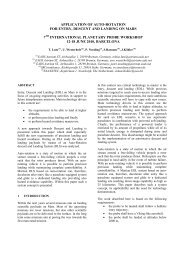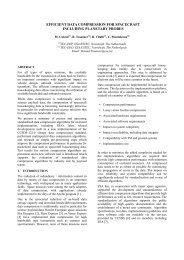Presentation 406 - International Planetary Probe Workshop
Presentation 406 - International Planetary Probe Workshop
Presentation 406 - International Planetary Probe Workshop
You also want an ePaper? Increase the reach of your titles
YUMPU automatically turns print PDFs into web optimized ePapers that Google loves.
The Evolution of the Mars Science Laboratory<br />
Heatshield (Part II)<br />
Robin A. S. Beck, Helen H. Hwang, , Michael J. Wright,<br />
David M. Driver, Eric M. Slimko<br />
7 th <strong>International</strong> <strong>Planetary</strong> <strong>Probe</strong> <strong>Workshop</strong><br />
Barcelona, Spain<br />
June 16, 2010
Outline<br />
Mars Science Laboratory<br />
• Introduction<br />
– Mars Science Laboratory unique entry environments<br />
– Review of presentation (Part 1), or What Went Wrong With the TPS<br />
• Change in Thermal Protection heatshield material<br />
– Development by Orion<br />
– MSL-specific development<br />
• Stagnation<br />
• Shear<br />
• Gap filler<br />
– Initial TPS margin assessment<br />
– Tile layout<br />
• Current status<br />
June 16, 2010 7 th <strong>International</strong> <strong>Planetary</strong> <strong>Probe</strong> <strong>Workshop</strong> (IPPW7) HHH-1
The MSL TPS Team<br />
• ARC:<br />
– Robin Beck<br />
– Deepak Bose*<br />
– James Brown<br />
– Alan Cassell (ELORET)<br />
– Y.K. Chen<br />
– Anthony DeCaro<br />
– David Driver<br />
– Tahir Gökçen* (ELORET)<br />
– Helen Hwang<br />
– Bernard Laub<br />
– Ed Martinez<br />
– Michael Olson*<br />
– Dinesh Prabhu (ELORET)<br />
– Steven Sepka (ELORET)<br />
– Kristina Skokova (ELORET)<br />
– Chun Tang<br />
– Todd White (ELORET)<br />
– Michael Wright<br />
– ARC Arc Jet Team<br />
– CEV ADP Team<br />
* CEV ADP Team member<br />
• LaRC:<br />
• JPL:<br />
– Karl Edquist<br />
– John Dec<br />
– Artem Dyakonov<br />
– Pamela Hoffman<br />
– Eric Slimko<br />
– Adam Steltzner<br />
– Christine Szalai<br />
• Lockheed Martin:<br />
– Jerry Brown<br />
– Richard Hund<br />
– Steven Jolly<br />
– Susan Linch<br />
– Kevin Makowski (ASI)<br />
– Katie Oakman<br />
– David Scholz<br />
– Jarvis Songer<br />
– Scott Stolpa<br />
– Joseph Vellinga<br />
– William Willcockson<br />
Mars Science Laboratory<br />
June 16, 2010 7 th <strong>International</strong> <strong>Planetary</strong> <strong>Probe</strong> <strong>Workshop</strong> (IPPW7) HHH-2
Mars Science Lab (MSL) Spacecraft<br />
Mars Science Laboratory<br />
Cruise Stage<br />
Backshell<br />
Descent<br />
Stage<br />
Rover<br />
Heatshield<br />
Entry<br />
Vehicle<br />
June 16, 2010 7 th <strong>International</strong> <strong>Planetary</strong> <strong>Probe</strong> <strong>Workshop</strong> (IPPW7) HHH-3
MSL Heatshield Peak Environments (based on<br />
original 2009 launch/ 2010 entry)<br />
• First Mars vehicle with turbulent flow on the heatshield<br />
• Conditions ~2x higher heating on any previous Mars mission<br />
Mars Science Laboratory<br />
Value<br />
Location of peak condition<br />
Peak q w<br />
(W/cm 2 )<br />
Peak w<br />
(Pa)<br />
Peak p w<br />
(atm)<br />
Q w<br />
(J/cm 2 )<br />
Max Heat Flux location 197 444 0.262 5477<br />
Max Shear Stress location 178 471 0.227 5054<br />
Max Pressure location 45 10 0.371 2219<br />
For details, see K.T. Edquist, A.A. Dyakonov, M.J. Wright, and C.Y. Tang, “Aerothermodynamic Design of the<br />
Mars Science Laboratory Heatshield,” AIAA 2009-4075.<br />
June 16, 2010 7 th <strong>International</strong> <strong>Planetary</strong> <strong>Probe</strong> <strong>Workshop</strong> (IPPW7) HHH-4
When we last left you…<br />
Mars Science Laboratory<br />
• Robin Beck presented at IPPW6, “The Evolution of the MSL Heatshield,”<br />
by R. Beck, D. Driver, and E. Slimko, June 2008.<br />
• Original baselined heatshield material, SLA-561V, performed well in<br />
stagnation arcjet testing<br />
– Glass vaporization allowed material to withstand q > 300 W/cm 2<br />
– No failures observed<br />
– Developed a high fidelity response model (HFRM), which accurately captured<br />
in-depth temperature response of material<br />
• HOWEVER, a series of arc jet testing in shear environments yielded<br />
material failures that were reproducible but not understood (and were not<br />
correlated to shear force!)<br />
June 16, 2010 7 th <strong>International</strong> <strong>Planetary</strong> <strong>Probe</strong> <strong>Workshop</strong> (IPPW7) HHH-5
Material Failures During Shear Testing<br />
Mars Science Laboratory<br />
• SLA-561V: all stagnation tests successful<br />
• In certain shear environments, material failed<br />
but unclear why (no clear correlation with q,<br />
p, tau, h, or any combination)<br />
• Although the location of the failure was<br />
somewhat stochastic, failure mechanism was<br />
reproducible at certain conditions<br />
• Team of experts could not conclusively find<br />
the “smoking gun”<br />
Initial Condition<br />
Cold wall heat flux = 175 W/cm 2<br />
Pressure = 0.30 atm<br />
Bulk Enthalpy = 14 MJ/kg<br />
3 second dwell<br />
9 second ramp to final condition<br />
Cold wall heat flux 165 W/cm 2<br />
Pressure = 0.39 atm<br />
Bulk Enthalpy = 8 MJ/kg<br />
12 second dwell<br />
June 16, 2010 7 th <strong>International</strong> <strong>Planetary</strong> <strong>Probe</strong> <strong>Workshop</strong> (IPPW7) HHH-6
T-2 Years to Launch: Decision Required!<br />
Mars Science Laboratory<br />
• In order to support the manufacturing schedule for the flight<br />
heatshield, the technical team had to make a recommendation if<br />
the material could still be used for MSL with a 2009 launch<br />
• Two heatshield options:<br />
– 1) Keep SLA-561V, but limit aerothermal environment < 100 W/cm 2 (at<br />
or below Pathfinder’s environment)<br />
– 2) Switch materials, knowing time is the enemy (any other material<br />
would require significant development work for a 2009 launch)<br />
• Option 1 would severely limit the overall mission, as modifying trajectory would:<br />
– Possibly limit landing sites (and thus negatively impact science objectives)<br />
– Adversely affect entry guidance robustness<br />
– Require more propellant<br />
• Decision: go with Option 2, work “smart” and fast, developing design in parallel with<br />
manufacturing!<br />
• What could we leverage from other projects? (Orion, human exploration mission to ISS and<br />
moon, was developing tiled PICA design)<br />
• No time to test material and determine thickness required before manufacturing began <br />
heatshield is 1.25” thick (limited by launch mass)<br />
June 16, 2010 7 th <strong>International</strong> <strong>Planetary</strong> <strong>Probe</strong> <strong>Workshop</strong> (IPPW7) HHH-7
New Direction: Define a New TPS for MSL<br />
Mars Science Laboratory<br />
• Switching heatshield materials would<br />
require a fast-paced schedule<br />
– The MSL spacecraft and mission were post-<br />
Critical Design Review<br />
– Heatshield would need to be developed,<br />
,<br />
designed, tested, built, and qualified in less<br />
than 18 months (based on April 2009<br />
delivery for the original October 2009 launch<br />
date)<br />
• A replacement heatshield material that<br />
could support this schedule would require<br />
– Proven ability to withstand t entry environment<br />
(peak heat flux, pressure, shear stress)<br />
– Reliable manufacturability<br />
– High fidelity thermal response model<br />
– Flight heritage<br />
• Only one material satisfied these<br />
requirements: Phenolic Impregnated<br />
Carbon Ablator (PICA)<br />
January 2006<br />
PICA:<br />
NASA<br />
Invention<br />
of the<br />
Year 2007<br />
June 16, 2010 7 th <strong>International</strong> <strong>Planetary</strong> <strong>Probe</strong> <strong>Workshop</strong> (IPPW7) HHH-8
Leveraging Development Investments in Orion<br />
Mars Science Laboratory<br />
• The Crew Exploration Vehicle Advanced Development Program (CEV ADP)<br />
for Orion had invested in the re-development and re-manufacturing of PICA as<br />
a candidate heatshield material, allowing FMI to improve their manufacturing<br />
process<br />
• Orion conducted 125 arcjet tests of PICA<br />
– Tested to more severe environments (heating, pressure, shear)<br />
– Various gap filler designs<br />
– Material characterization ti (material property tests) t performed<br />
– High fidelity response model developed for in-depth thermal and recession<br />
response<br />
• MSL could simplify design because the aeroshell structure t was composite (vs<br />
metallic for Orion) and the CTE agreement was better<br />
– Lower deflections for MSL: direct bonding to structure, and filled gaps were<br />
possible<br />
– Less severe environments thinner TPS for MSL<br />
• MSL tests at lower conditions also informed Orion about PICA’s suitability as a<br />
heatshield hi candidate material, thus both projects benefited<br />
June 16, 2010 7 th <strong>International</strong> <strong>Planetary</strong> <strong>Probe</strong> <strong>Workshop</strong> (IPPW7) HHH-9
Flow direction<br />
Different material, different response<br />
Mars Science Laboratory<br />
• SLA-561V failed in swept cylinder<br />
testing, moderate environments:<br />
– q hw ~ 120 W/cm 2<br />
– p ~ 0.22 atm<br />
– ~ 300 Pa<br />
– h ~ 14 MJ/kg<br />
– t = 3.4 sec!<br />
• CFD calculations using DPLR show<br />
peak heat flux occurs downstream<br />
• New heatshield material would have<br />
to perform well in these conditions!<br />
• At same test conditions, PICA does<br />
not tfail and shows no anomalous<br />
behavior<br />
Further details on the experiment: D.M. Driver, J.E. Carballo,<br />
R. Beck, D. Prabhu, J. A. Santos, A. Cassell, K. Skokova, C.<br />
Tang, and H.H. Hwang, “Arc Jet Testing in a Shear<br />
Environment for Mars Science Laboratory Thermal Protection<br />
System,” AIAA 2009-4230.<br />
June 16, 2010 7 th <strong>International</strong> <strong>Planetary</strong> <strong>Probe</strong> <strong>Workshop</strong> (IPPW7) HHH-10
Parallel Development and Design Approach<br />
Mars Science Laboratory<br />
• Due to schedule constraints, MSL approached the heatshield design<br />
in a non-conventional way<br />
– PICA thickness was determined by the maximum mass allowed by the<br />
spacecraft mass budget<br />
• Uniform thickness of 1.25-in over most of the heatshield<br />
• Thickness margins were evaluated as test data was gathered (including<br />
uncertainty analyses); usual method of designing material thickness to a<br />
required thickness margin was not possible given short schedule<br />
– Heatshield design (tile layout, cut plans, etc) was occurring in parallel with<br />
thermal and thermostructural analysis and development testing<br />
• Maximum allowable gap size was determined from successful CEV tests on<br />
filled gaps and later refined through thermal and structural analysis and verified<br />
through tests<br />
• Angles between tile gaps and flowfield streamlines were based on previous<br />
tiled heatshield requirements (>20 for gaps longer than 6”) and testing<br />
limitations<br />
• PICA’s transverse isotropic behavior (k_ inplane > 2 * k_ TT ) led designers to tile<br />
designs that limited the fiber direction to
MSL Thermal Development for PICA<br />
Mars Science Laboratory<br />
• Arc jet testing > 100 specimens<br />
– Stagnation tests with in-depth instrumentation from low to peak heating<br />
conditions to verify PICA thermal response model in MSL environment<br />
space<br />
– Stagnation tests on gap-filled specimens at low and high heat fluxes with<br />
and without pre-cooling to simulate cruise-to-entry effects<br />
– Shear on wedges and swept cylinders at Ames and AEDC<br />
• Comparison of the response of the PICA to thermal response model predictions<br />
• Effects of fiber direction<br />
• Gap filler response<br />
• Damaged or flawed acreage and/or gaps<br />
• Repair methods<br />
• Coating behavior<br />
– PTF and TFD testing on long gaps<br />
• Effects of very low heating<br />
• Effects of turbulent flow over gaps<br />
June 16, 2010 7 th <strong>International</strong> <strong>Planetary</strong> <strong>Probe</strong> <strong>Workshop</strong> (IPPW7) HHH-12
PICA Recession in Stagnation Flow<br />
Mars Science Laboratory<br />
• The predicted d recession rates agreed within ±20% to the measured values<br />
over MSL-relevant conditions except at low heat rates<br />
• Calculated recession rates use TITAN, a 2D thermal response model.<br />
Details on TITAN calculations: Y.K. Chen, T. Gökçen, K.T. Edquist, “Two-Dimensional Ablation and Thermal<br />
Response Analyses for Mars Science Laboratory Heatshield,” AIAA 2009-4235.<br />
June 16, 2010 7 th <strong>International</strong> <strong>Planetary</strong> <strong>Probe</strong> <strong>Workshop</strong> (IPPW7) HHH-13
PICA in shear: well-behaved and no<br />
signs of failure<br />
Mars Science Laboratory<br />
• PICA material is robust at all tested conditions<br />
• RTV-560 filled gaps perform well<br />
• Recession rates vary from model predictions<br />
(up to 150%) factored into margins<br />
June 16, 2010 7 th <strong>International</strong> <strong>Planetary</strong> <strong>Probe</strong> <strong>Workshop</strong> (IPPW7) HHH-14
Gap Filler Response in Arc Jet Testing<br />
Mars Science Laboratory<br />
• Gap response dependent upon heating conditions<br />
– High heating – gaps at any angle with the flowfield experienced recession<br />
comparable to the surrounding PICA<br />
– Low heating – gaps at low angles with the flowfield protruded<br />
q<br />
Q cw = 350 W/cm 2 Q cw = 140 W/cm 2 Diff < 0.5mm<br />
= 323 W/cm 2<br />
FLOW<br />
FLOW<br />
Diff < 0.5mm<br />
FLOW<br />
Diff < 0.5mm<br />
Diff > 3 mm<br />
FLOW<br />
Diff < 0.5mm<br />
q cw = 323 W/cm 2<br />
Diff > 7mm<br />
q cw = 133 W/cm 2<br />
June 16, 2010 7 th <strong>International</strong> <strong>Planetary</strong> <strong>Probe</strong> <strong>Workshop</strong> (IPPW7) HHH-15
PICA Bondline Temperature Predictions<br />
Mars Science Laboratory<br />
rature (°C)<br />
Bon neline Tempe<br />
70<br />
60<br />
50<br />
40<br />
30<br />
20<br />
10<br />
0<br />
0 50 100 150 200 250 300 350 400<br />
Time (s)<br />
Composite<br />
Face<br />
Sheets<br />
Ten months from<br />
start of PICA effort!<br />
Material Stack-up<br />
PICA<br />
Flex Core<br />
Adhesive<br />
• Bondline requirement is maximum temperature of 250 °C (thermal margin > 180 °C)<br />
• Thermal model predictions at the region of highest recession indicate that the<br />
bondline temperature t should reach a maximum of 70 °C during entry<br />
• Analysis and margining process predict 0.94” required (vs 1.25” as-built), or 0.31” of<br />
extra material on heatshield<br />
From M.J. Wright, R.A.S. Beck, K.T. Edquist, D. Driver, S.A. Sepka, E.M. Slimko, W.H. Willcockson, A. DeCaro,<br />
and H.H. Hwang, “Sizing and Margins Assessment of the Mars Science Laboratory Aeroshell Thermal<br />
Protection System,” AIAA 2009-4231.<br />
June 16, 2010 7 th <strong>International</strong> <strong>Planetary</strong> <strong>Probe</strong> <strong>Workshop</strong> (IPPW7) HHH-16
MSL Heatshield Layout<br />
• 27 different tile drawings for 113 tiles<br />
-135 Transition Tile<br />
-134 Transition Tile<br />
Mars Science Laboratory<br />
-136 Shoulder Tile<br />
-131<br />
-125<br />
-104 -106<br />
-115<br />
-133 -123<br />
-127<br />
-103<br />
-121 -142 -141<br />
-105<br />
-111<br />
-114<br />
-107 -112<br />
Flow<br />
-132<br />
-126<br />
-122<br />
-108<br />
-113<br />
-128<br />
-124<br />
+Y<br />
+X<br />
• 19 PICA lots (114 billets) of PICA were manufactured for MSL testing,<br />
development, and production with lot acceptance testing performed on<br />
every billet<br />
From R.A.S. Beck, D.M. Driver, M.J. Wright, B. Laub, H.H. Hwang, E.M. Slimko, K.T. Edquist, S.A. Sepka, W.H.<br />
Willcockson, and T.D. Thames, “Development of the Mars Science Laboratory Heatshield Thermal Protection<br />
System,” AIAA 2009-4229.<br />
June 16, 2010 7 th <strong>International</strong> <strong>Planetary</strong> <strong>Probe</strong> <strong>Workshop</strong> (IPPW7) HHH-17
Heatshield TPS Margin Assessment<br />
Mars Science Laboratory<br />
• Very conservative thermal margins analysis show that 1.25-in thick as-<br />
built heatshield hi >> 0.94-in requirement for 2009 launch<br />
– Outstanding liens against the 0.94-in requirement still exist<br />
• Discrete roughness heating augmentation due to protruding gaps<br />
• 2012 trajectory differences: entry velocities are higher, leading to slightly higher<br />
peak heat fluxes and heat loads<br />
– Initial evaluations of the outstanding liens show that the current design is<br />
still robust<br />
– Final closure of the liens expected in 2010<br />
• The MSL project developed, designed, tested, built and qualified a<br />
4.5-m tiled ablative heatshield in 18 months<br />
• This heatshield will be NASA’s first tiled ablative flight article<br />
June 16, 2010 7 th <strong>International</strong> <strong>Planetary</strong> <strong>Probe</strong> <strong>Workshop</strong> (IPPW7) HHH-18
Completed MSL Flight Heatshield<br />
Mars Science Laboratory<br />
• 4.5-m diameter tiled ablative heatshield (with in-depth instrumentation!)<br />
June 16, 2010 7 th <strong>International</strong> <strong>Planetary</strong> <strong>Probe</strong> <strong>Workshop</strong> (IPPW7) HHH-19
Work To Go<br />
Mars Science Laboratory<br />
• Analysis underway for new entry environments<br />
based on updated trajectories for December<br />
2011 launch/August 2012 entry<br />
– Peak heating and peak heat load are higher<br />
than for the 2009 trajectories<br />
– TPS sizing margins will be recalculated and<br />
reviewed by September 2010; initial assessment<br />
shows max thickness required is 1.01 inches (vs<br />
as-built thickness of 1.25 inches)<br />
• Inspection of the flight heatshield will be<br />
conducted in mid-June 2010 to verify that there<br />
are no problems with the aging PICA and RTVfilled<br />
gaps<br />
• Pressure transducers will be installed in early<br />
2011<br />
June 16, 2010 7 th <strong>International</strong> <strong>Planetary</strong> <strong>Probe</strong> <strong>Workshop</strong> (IPPW7) HHH-20
We’ve come a long way…<br />
• In 2001, Mars Smart Lander: • In 2010, Mars Science Laboratory:<br />
Mars Science Laboratory<br />
• Launch date in 2005<br />
• Peak heat flux of ~170 W/cm 2 (about 1.4<br />
times greater than Pathfinder), laminar<br />
• Asymmetric aeroshell geometry; much<br />
lighter payload (rover); mission “creep”<br />
quickly resulted; 4.05m diam<br />
• Launch date in December 2011 (originally<br />
scheduled for Sept. 2009)<br />
• Peak heat flux of 226 W/cm 2 , fully<br />
turbulent boundary layer before peak<br />
heating<br />
• Symmetric shape; tiled heatshield; rover<br />
much larger than original design;<br />
instrumented heatshield; 4.5m diam<br />
June 16, 2010 7 th <strong>International</strong> <strong>Planetary</strong> <strong>Probe</strong> <strong>Workshop</strong> (IPPW7) HHH-21
Acknowledgments<br />
Mars Science Laboratory<br />
• We gratefully acknowledge NASA-SCAP for their critical financial support<br />
of the arc jet operational capability at Ames.<br />
• Many thanks to the CEV TPS ADP team, which spent more than a year<br />
developing and testing the concept of a tiled-PICA design. Team<br />
members were generous with their time and knowledge and the MSL<br />
heatshield would not be in existence without their help!<br />
June 16, 2010 7 th <strong>International</strong> <strong>Planetary</strong> <strong>Probe</strong> <strong>Workshop</strong> (IPPW7) HHH-22


